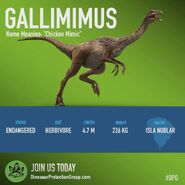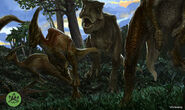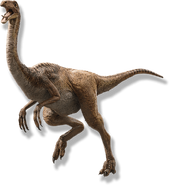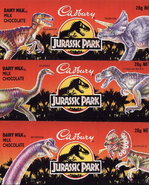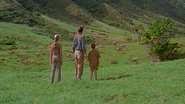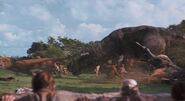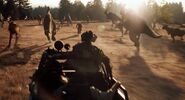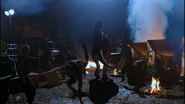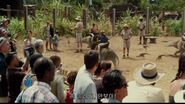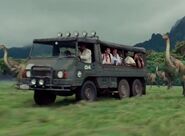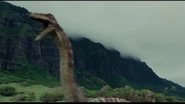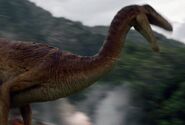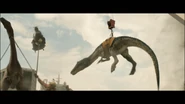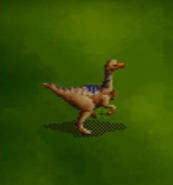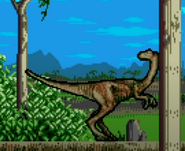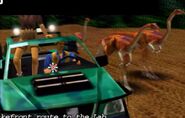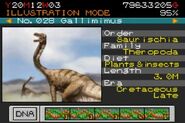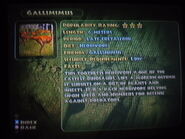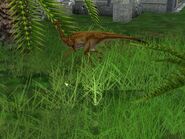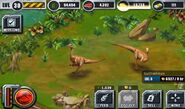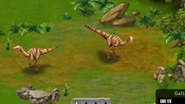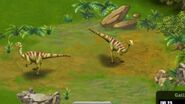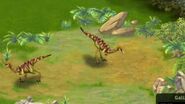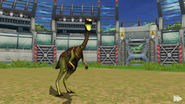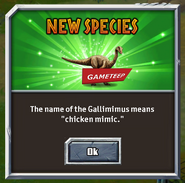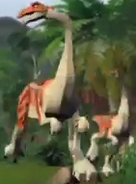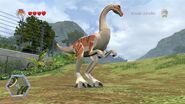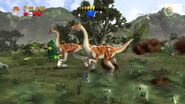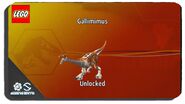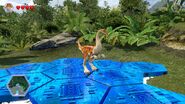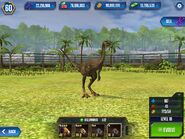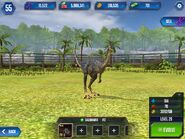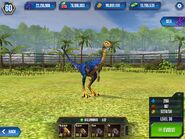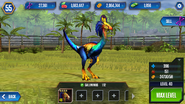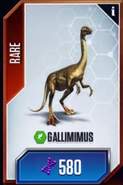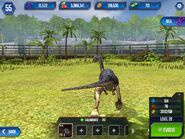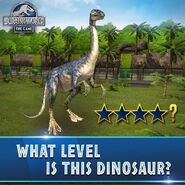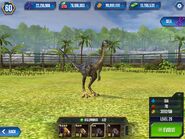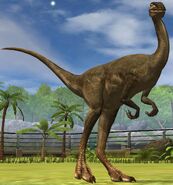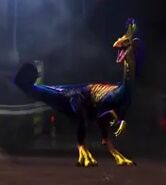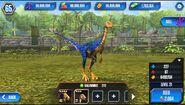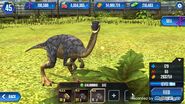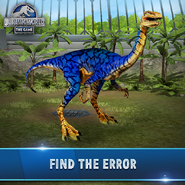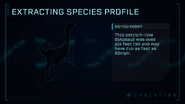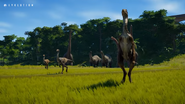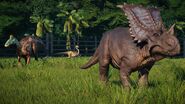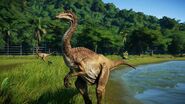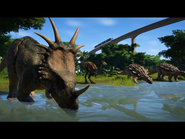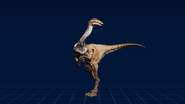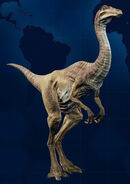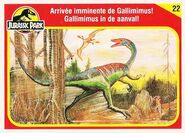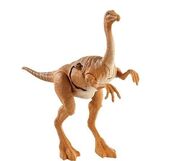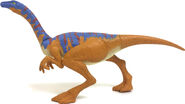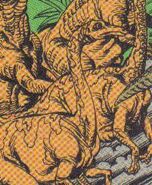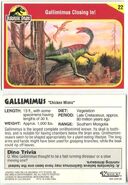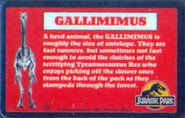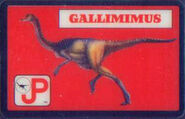- "They're flocking this way."
- —Tim Murphy(src)
Gallimimus was a speedy theropod, the largest of its type. They were called chicken mimics because they probably moved like modern flightless birds. Unlike other theropods, Gallimimus had no teeth. In fact, it had a very small head. This was probably one of the fastest dinosaurs, with speed like an ostrich, it could probably run up to 30 miles per hour.
With its small, toothless head, it is believed that Gallimimus probably had a diet of insects, small animals, eggs, and maybe even some plants. They had very long fingers and long arms, which they could use for digging or grabbing eggs. They had a much longer neck than any other theropod dinosaur. In Jurassic Park they were shown as a large flock, but we don't know if that was real or movie behavior.[1]
| Wikipedia has a more detailed and comprehensive article on Gallimimus |
They were refered to as "meatosauruses" by Lex Murphy.
Story
Creation

A flock of Gallimimus on Isla Nublar.
Forty four Gallimimus were successfully recreated by InGen[2] in the lab[3] on Isla Sorna[4][3] where they were parented and fed in captivity on the island.[3] The cloned Gallimimus moved in flocks and had a color scheme that varied depending on an individual's age[2] and gender.[citation needed]
Like all of InGen's cloned theropods, Gallimimus had pronated hands. Because of a Null allele created from the mutation and manipulation of its genes as well as the addition of frog, reptile, and bird DNA, the cloned Gallimimus lacked feathers.[5]
The males were occasionally a bright orange and darkened patterns of red and orange from head to tail,[citation needed] the females were duller in color from most of the body having a peachy color along with three shades of brown (beige, sand, tan), need least to say about their neck and head which were purplish with dark purple stripes over with a streamline of orange leading up to the head which ended off with a bright yellow. Unlike the adults, the juveniles have a color scheme based on much like that of fawn. They have a mossy green almost translucent color to their bodies and have a diverse number of spots on over them.[2]
Twenty four Gallimimus were transported to the island Isla Nublar[4] to live in the Gallimimus Enclosure of Jurassic Park.[2]
Isla Nublar Incident (1993)
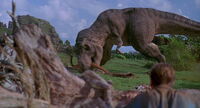
Jurassic Park's Tyrannosaurus killing an unluckey Gallimimus as Dr. Grant, Lex, and Tim watch.
When Dennis Nedry disabled Jurassic Park's electric fences, Gallimius was free to roam the island like most of the dinosaurs in the park.
On the second day of the Isla Nublar Incident, Dr. Alan Grant and the Murphy children witnessed a Gallimimus flock in its enclosure fleeing from Jurassic Park's Tyrannosaurus rex. The T. rex managed to kill one unlucky individual who tripped on another Gallimimus when the flock was running for safety.[2] This individual's remains would remain on the island for over a decade and was still there in the same location as it died in 2002.[6]
By 1994, the Gallimimus population on Isla Nublar had been brought down to nine individuals because of continuous Tyrannosaur attacks.
Wild on Isla Sorna
When Hurricane Clarissa struck Isla Sorna, the InGen personnel left the island. The twenty remaining bird-like dinosaurs were either set free by the workers or broke out on their own because the storm had damaged the fences. Gallimimus roamed freely across the island.[4]
The theropods had to learn to live in the wild. Since they no longer received lysine supplements in their food, they started to eat lysine rich foods.[4]
They were known to have resided in the southeast of Isla Sorna coexisting with other herbivores Mamenchisaurus, Parasaurolophus, and Pachycephalosaurus. Galimimus also made up a good portion of the fauna of that region.[4]
Isla Sorna Incident (1997)
During the Isla Sorna Incident of 1997 two adult Gallimimus was captured by the InGen Hunters for Peter Ludlow's Jurassic Park San Diego, but was freed the following night by Nick Van Owen and the Gatherers along with the rest of the dinosaurs held captive by the hunters.[4]
Jurassic World
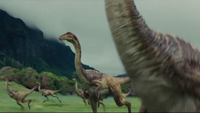
Gallimimus stampede in Jurassic World
Gallimimus was one of the many dinosaurs that lived in Masrani Global Corporation's dinosaur park, Jurassic World. They retained many characteristics of the previous clones albeit being a foot taller and having teeth which is inaccurate to the real animal and being different colors, dull orange with a creamy underbelly and brown stripes on the backs. The theropods lived in the self-titled Gallimimus Valley. Some of the juveniles also lived in the Gentle Giants Petting Zoo.[7]
Jurassic World: Fallen Kingdom

Gallimimus running from Mount Sibo in Jurassic World: Fallen Kingdom
It is revealed that there are surviving Gallimimus populations on Isla Nublar, as they will now face an impending danger, alongside many other creatures, in the form of an erupting volcano.
They were seen running alongside many other species away from Mount Sibo. Some Gallimimus were also captured and taken to Lockwood Manor but thanks to Claire Dearing and Maisie Lockwood, they would eventually escape the estate along with the other dinosaurs. Gallimimus inhabited several basement cages, knowing that there were at least 3 Gallis in cage 02.
Gallery
Promnotional Images
Jurassic Park
The Lost World: Jurassic Park (film)
Jurassic World
Jurassic World: Fallen Kingdom
Vocalizations
The Lost World
In The Lost World, Gallimimus is indirectly referenced, proving that it exists on Isla Sorna in the novel universe. Its name (Gallimimus bullatus) is printed all over a document addressed to Dr. Henry Wu, among the dozens spread all over the abandoned InGen Compound.In The Evolution of Claire, it is listed as one of the five species residing in Gyrosphere Valley. They are only seen once when three of them race a jeep.
Jurassic Park (SNES game)
Multiple herds of Gallimimus appears in the SNES game Jurassic Park. They can be killed by the player. The dinosaurs won't attack the avatar directly. They move in the following cycle. The animals stand still in a row for some time. Then they simultaneously run to the other side of the field. On the other side, they will wait in formation until they run back. If the player happens to be in the path of the Gallimimus, they lose HP.
Jurassic Park: Rampage Edition
Dr. Grant can mount a Gallimimus during the "Savannah" level in Jurassic Park: Rampage Edition.
Jurassic Park (arcade game)
Gallimimus is encountered in the Jurassic Park arcade game.
The Lost World: Jurassic Park (arcade game)
Herds of Gallimimus are encountered in the The Lost World: Jurassic Park arcade game.
Jurassic Park: Trespasser
An unused quote from Jurassic Park: Trespasser has Hammond state that Gallimimus thrived as the fasted dinosaur on Isla Sorna, assuming they would make an appearance in the game; however, this idea was scrapped.
Jurassic Park III: Island Attack
Gallimimus appears in Jurassic Park III: Island Attack.
Jurassic Park III: The DNA Factor
Gallimimus appears in the game Jurassic Park III: The DNA Factor.
Jurassic Park III: Park Builder
It is one of the Carnivore Ones that can be created in Jurassic Park III: Park Builder.
Jurassic Park: Dinosaur Battles
It is a weak opponent in Jurassic Park: Dinosaur Battles that can be defeated with any dinosaur.
Jurassic Park: Explorer
Gallimimus is featured in the DVD game Jurassic Park: Explorer.
Jurassic Park: Operation Genesis
see Gallimimus/Operation Genesis
In the video game Jurassic Park: Operation Genesis, Gallimimus is a three-star herbivore from the Flaming Cliffs formation along with the Velociraptor and the Homalocephale, much like the real world. The coloration resembles very closely to the Jurassic Park Gallimimus. It is inaccurately depicted as a herbivore, when it, in both real life and Jurassic Park, is an omnivore. This is possibly due to their limitations that resemble a herbivore. Gallimimus can coexist with Dryosaurus and other herbivores and appears to be one of the hardest herbivores to catch by most carnivore dinosaurs. It appeared in the game's demo as well. The lifestyle of the Gallimimus in this game much more disorganized than in films where the Gallimimus are thought to evade live in flocks. Though much of this is true in the game the Gallis tend to separate from the herd and end up getting lost. When in a herd the Gallis frequently run on a natural basis, but when isolated from a herd they always stop running and normally walk.
Jurassic Park: Builder
Gallimimus is one of the available dinosaurs on the IOS application, Jurassic Park: Builder. Much like Jurassic Park: Operation Genesis, it is inaccurately depicted as a herbivore, when it, in both real life and Jurassic Park, is an omnivore. This is also possibly due to their limitations that resemble a herbivore and sharing the Dryosaurus model and animation.
Jurassic Park: the Game
Gallimimus was used in promotional material for Jurassic Park: The Game, but did not appear in the game itself
LEGO Jurassic World
Gallimius appears in the Jurassic Park and Jurassic World sections of the video game LEGO Jurassic World.
Jurassic World: The Game
Gallimimus is one of the available dinosaurs on the IOS application, Jurassic World: The Game. Much like Jurassic Park: Operation Genesis and Jurassic Park: Builder, it is inaccurately depicted as a herbivore, when it, in both real life and Jurassic Park, is an omnivore. This is also possibly due to their limitations that resemble a herbivore.
Jurassic World: Evolution
see Gallimimus/JW: E
Gallimimus appears in Jurassic World: Evolution. It was first revealed by its' species profile. Its' design is based on the Jurassic World and Jurassic World: Fallen Kingdom variants. Much like Jurassic Park: Operation Genesis, Jurassic World: The Game and Jurassic Park: Builder, it is inaccurately depicted as a herbivore, when it, in both real life and Jurassic Park, is an omnivore. This is also possibly due to their limitations that resemble a herbivore.
Jurassic World: Alive
see Gallimimus/JW: A
Gallimimus is a common in Jurassic World: Alive. Its' design is based on the Jurassic World and Jurassic World: Fallen Kingdom variants.
Jurassic Park Series 2
Two Gallimimus appear in the Jurassic Park Series 2 toy line. One is a hatchling that is included with the Ian Malcolm figure and the other is an adult. The adult is one of the rarest and most expensive figures in the toy line.
Die-Cast: Jurassic Park
Gallimimus appears in the Die-Cast: Jurassic Park toy line packaged with Pteranodon.
LEGO Jurassic World
A Gallimimus figure is included in the LEGO Jurassic World set 30320 Gallimius Trap, which is a pre-order bonus for the LEGO Jurassic World video game. Because it reuses the Coelophysis mold from LEGO's previous Dino toy line, the figure has a mouth full of teeth with two pairs of buck teeth at the front of the mouth, much like a heterodontosaurid. This makes this toy one of the most inaccurate depictions of Gallimius in the Jurassic Park franchise.
Jurassic World: Fallen Kingdom
A new figure of Gallimimus will be released as part of the toyline for Jurassic World: Fallen Kingdom.
This section needs content.
Behind the scenes
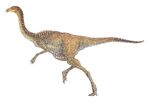
Jurassic Park Gallimimus concept art by Mark "Crash" McCreery.
The Gallimimus stampede featured in the first film was envisioned very early in its development by Steven Spielberg.[8] The scene itself appears is an adaptation of a similar event in the chapter "Dawn" of the first novel which featured Grant and the Murphys witnessing the adult T. rex chase a herd of Hadrosaurus. Phil Tippett proposed that the Hadrosaurus herd be replaced by that of Gallimimus because they "could reach a higher speed"[9] and this proposal later became final.
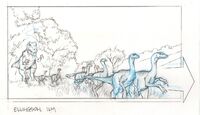
Storyboard by TyRuben Ellingson of the Gallimimus flocking scene.
When designing the Gallimimus for Jurassic Park, conceptual artist Mark "Crash" McCreery used the modern Emu as the main source of reference in its design.[10] Director Steven Spielberg wanted the Gallimimus to be bird-like[11] as well as wanting its color scheme to be like that of a colorful bird.[12] Paul Mejias sculpted the maquette from McCreery's concept art and finished sculpting it in March of 1992. This maquette would be used by ILM for both the adults and juveniles of the herd seen in the film.[13] When creating the legs of the sculpture, Paul used reference photos of ostrich feet.[11] Steven Spielberg picked a color scheme out of several coloration designs created by various crewmembers of Stan Winston Studios.[12] The design selected was different than that seen in the final film. The painted maquette was a dark brown with dark blue striping instead of bright earth orange and white like that seen in film's Gallimimus.[14]
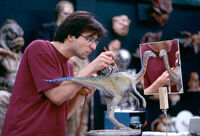
Paul Mejias painting the Gallimimus maquette for Jurassic Park. Note the blue in its color scheme that is absent from the final design of the films' Gallies.
Tests of a computer-generated of a Gallimimus herd and a Tyrannosaurus created by Industrial Light and Magic was what convinced Spielberg to replace the go motion dinosaurs that were planned to be used in for wide shots of said creatures solely with CGI. Though Phil Tippett had added a motion blur to the stop motion dinosaurs that was absent from previous films that featured go motion creatures, such as 1963's Jason and the Argonauts, but Speilberg felt that the movements of the dinosaurs were still jerky. Dennis Muren then suggested to Speilberg that ILM create computer generated full-sized dinosaurs. Interested, Speilberg requested a test be made featuring CGI dinosaurs. In the first of a series of tests, ILM created a herd of Gallimimus running[15] through a still photograph of Hawaii.[16] Steven was impressed by the how smooth the Gallimimus moved[15] as well as how authentic the rendering was,[16] but he was not fully convinced to use CGI for the dinosaurs until ILM made more tests featuring a fully fleshed T. rex and said T. rex chasing a herd of fully fleshed Gallimimus.[15]
The flocking scene was filmed at Kualoa Ranch on the Hawaiian island of Oahu due to Hurricane Iniki canceling further filming on Kauai.[17] It was to be the last scene to be filmed in Kuai before the hurricane occurred.[18] The Gallimimus herd in Jurassic Park were the next dinosaurs that ILM created after the Brachiosaurus during post production. The ostrich was used as an animation reference for the Gallies by ILM.[15] Another reference for animating the herd, particularly when they jumped over the fallen tree, was simply personnel for the movie running and jumping over a scale version of the fallen tree while being filmed. During the filming of this reference footage, TyRuben Ellingson—who created the storyboard for the flocking scene and participated in the shooting of the footage—accidently tripped over the scale log and broke the elbow of his drawing arm, an injury that required him to have surgery. When Phil Tippit heard of Ellingson's accident, he said "Well, then one of the Gallis is going to need to take a fall. If it happened to Ty, it would have likely have happened in the wild." Because of this, the animators included a Gallimimus that trips on the fallen tree and falls to the ground before regaining balance during the flocking sequence.[8] The color scheme of the adult Gallis was changed by ILM to more bright earth orange and white. The creator of the Gallimimus maquette Paul Mejias personally preferred the color the digital artists chose.[12] The Gallimimus was the only dinosaur in the first film that was never physically on set but was instead entirely CGI.
The sounds made by the Gallis in the first film drew from various sources. The sound of the stampeding flock was created from actual, yet smaller, stampedes of cattle and horses.[19] The Gallimimus squeals came from a female horse[20] while the sound that the Tyrannosaurus makes when she shakes the Gallimimus that she promptly kills was simply Gary Rydstrom's dog playing with a rope toy.[15]
In its appearance in The Lost World: Jurassic Park, the Gallimimus model from the previous film was updated for the sequel.[21]
In the original storyboards of the second film's official ending, the other dinosaurs of Isla Sorna, but the ostrich-like dinosaur was cut from the final production.[citation needed]
It's very odd that on the Jurassic World website, Gallimimus have teeth in the model when in the movie, there is no real sign of teeth and the website itself says they have no teeth.[22][23]
References
- ↑ Cite error: Invalid
<ref>tag; no text was provided for refs namedJPI - ↑ 2.0 2.1 2.2 2.3 2.4 Jurassic Park
- ↑ 3.0 3.1 3.2 Jurassic Park III
- ↑ 4.0 4.1 4.2 4.3 4.4 4.5 The Lost World: Jurassic Park
- ↑ RUFFLED FEATHERS
- ↑

- ↑ Jurassic World
- ↑ 8.0 8.1 Sosa, J.L. (2015, June 12) ‘I Was a Failed Gallimimus’: Jurassic Park Through The Eyes of One of Its Magic Creators. Retrieved http://filmschoolrejects.com/features/jurassic-park-tyruben-ellingson.php
- ↑ Phil Tippett (2014). Phil Tippett Interview - 5th February 2014, JurassicWorld.org, Feb 5, 2014.
- ↑ Jurassic Park Topps trading cards: Card #80 - Gallimimus
- ↑ 11.0 11.1 paulmejias.com - Jurassic Park, Page 2. Retrieved from http://paulmejias.com/character-effects/jurassic-park-image-2.html
- ↑ 12.0 12.1 12.2 paulmejias.com - Scrapbook. Retrieved from http://paulmejias.com/scrapbook/studio-shots-image-11.html
- ↑ paulmejias.com - Jurassic Park, Page 1. Retrieved from http://paulmejias.com/character-effects/jurassic-park-image-1.html
- ↑ paulmejias.com - Additional Shots. Retrieved from http://www.paulmejias.com/scrapbook/additional-shots-image-1.html
- ↑ 15.0 15.1 15.2 15.3 15.4 The Making of Jurassic Park
- ↑ 16.0 16.1 Return to Jurassic Park: Dawn of a New Era
- ↑ The Making of Jurassic Park, p. 135.
- ↑ The Making of Jurassic Park, p. 85.
- ↑ YouTube - Jurassic Park (1993) - Gary Rydstrom Sound FX
- ↑ Buachann, Kyle. (June 9, 2015) You’ll Never Guess How the Dinosaur Sounds in Jurassic Park Were Made. Vulture.
- ↑ The Making of The Lost World, p. 58
- ↑ http://www.jurassicworld.com/dinosaurs/gallimimus/
- ↑ http://www.jurassicworld.com/park-map/gallimimus-valley/
Template:JPI Dinosaurs
| Compsognathus • Gallimimus • Mamenchisaurus • Pachycephalosaurus • Parasaurolophus • Pteranodon • Stegosaurus • Triceratops • Tyrannosaurus rex • Velociraptor |
| Ankylosaurus • Apatosaurus • Dimorphodon • Gallimimus • Indominus rex • Mosasaurus • Pachycephalosaurus • Parasaurolophus • Pteranodon • Stegosaurus • Triceratops • Tyrannosaurus rex • Velociraptor |
Template:JPV Dinosaurs



